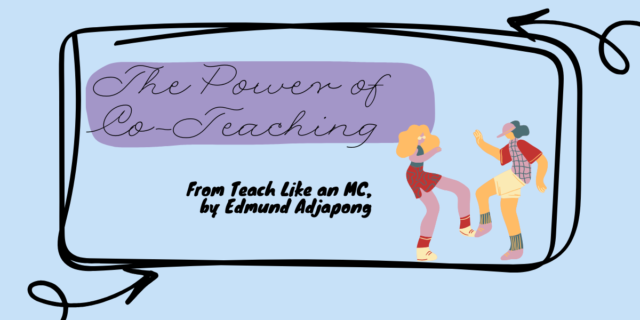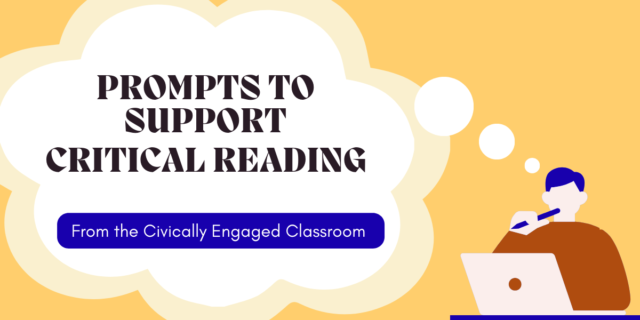Sonja Cherry-Paul and Dana Johansen have been friends since meeting on their first night of classes at Teachers College. Sonja discovered the true work required in interpretation while listening to her fifth graders’ book club, and she and Dana then decided they needed to find out what interpretation really looks like in the classroom.
Sonja Cherry-Paul and Dana Johansen have been friends since meeting on their first night of classes at Teachers College. Sonja discovered the true work required in interpretation while listening to her fifth graders’ book club, and she and Dana then decided they needed to find out what interpretation really looks like in the classroom.
 In Teaching Interpretation: Using Text-Based Evidence to Construct Meaning, Sonja and Dana show how students can successfully form interpretations whatever their reading level or age. In today’s post Sonja and Dana discuss the evolution of the book and point out that even experienced readers have a hard time with interpretation.
In Teaching Interpretation: Using Text-Based Evidence to Construct Meaning, Sonja and Dana show how students can successfully form interpretations whatever their reading level or age. In today’s post Sonja and Dana discuss the evolution of the book and point out that even experienced readers have a hard time with interpretation.
What led you to team up and write Teaching Interpretation?
We were so lucky to meet each other at Teachers College and find a common passion in teaching! We instantly connected over the things we love: good food, dogs, picture books, and of course, teaching reading and writing. Over iced teas and Ollie’s Chicken Lo Mein, we talked about what we were teaching that week, the books our students loved, and what we were struggling with. In one such conversation, we confessed that teaching interpretation was challenging. What did this word really mean? How could we demystify this critical-thinking process for our students? We both wanted to improve this area of our teaching, so we made a plan. We read everything we could get our hands on about teaching interpretation, learned as much as possible from our mentors and advisors at Teachers College about teaching reading, and identified strategies we wanted to try in our classrooms. Inspired by the work of Lucy Calkins, Stephanie Harvey, Kylene Beers, Chris Lehman, and Kate Roberts, we brainstormed ideas and designed minilessons. Some worked, some didn’t. We discarded some strategies and revised others until we felt they truly raised the quality of our students’ interpretations. Sometimes we spent months discussing and debating a single topic—teaching students how to identify and interpret the tone of a text, for example. Teaching Interpretation is the product of our teaching, our research, and our (sometimes hair-pulling) brainstorming sessions. The strategies included are tried and true. After seeing the results in our students’ learning, we wanted to share our work with fellow teachers. We feel so grateful for this opportunity and have loved getting to know the Heinemann family.
You say in the book that your goal is to help teachers develop their students’ ability to “analyze, synthesize, and interpret literature and information texts.” How did you identify this need?
Looking back on our teaching careers, we remembered the difficulties many of our students had trying to analyze symbolism, theme, and figurative language. We recalled listening to the ideas of those few precocious students who seemed to interpret texts effortlessly while their peers looked on in clueless awe. We struggled with how to teach interpretation in ways that would reach all of our students. How could we help all students make strong claims, revise their ideas, and locate evidence in the text? When we asked our students to interpret a text, some would come up with ideas quickly but with no evidence to support them, while others struggled even to come up with an idea. We also had advanced readers in our classrooms, our precocious students, and we needed strategies that would challenge their thinking and push them to form stronger interpretations. We wrote Teaching Interpretation as much for ourselves as for our fellow teachers.
In teaching, time is precious; we need strategies that will meet the needs of all our learners and raise the quality of their work. In Teaching Interpretation we provide strategies, text recommendations, and teaching tips that can be easily incorporated into any curriculum. This way, you’re not changing your program, you’re raising the quality of the work you’re already doing. We wrote the book with our own “dream list” of teaching tools in mind. We love books that have strategies for differentiated instruction, text recommendations, and sample lessons, so these features are prominent. We include assessments and strategies for both novice and advanced readers, recommendations for print-based and digital texts, and sample lessons that can be used for preteaching, launching, reviewing, and solidifying concepts. Our favorite feature in Teaching Interpretation is the QR codes throughout the chapters that link teachers to “digital bins,” free digital text sets they can use to teach interpretation. These digital texts increase student motivation and engagement.
You point out that even experienced or fluent readers have a hard time with interpretation. Why do you think that’s the case?
The ability to construct strong interpretations is not related to reading levels and Lexile measurements. Just because students are considered advanced readers doesn’t mean they are thinking critically about what they are reading. Stephanie Harvey discusses this in her workshops and reminds us that text complexity is not about the words but about ideas. Interpretation is a circuitous process. Some of our strongest readers struggle the most with interpretation because they maintain myopic viewpoints and do not consider other interpretations. Or our students are afraid to take risks in forming interpretations because they fear being wrong. Thankfully, the process of forming interpretations can be demystified for all students. For advanced readers, this may mean having them look at a variety of texts and encouraging them to try on varied lenses and perspectives.
In our next post, Dana and Sonja talk about their writing influences, their mentors, and how they balance life while teaching, completing doctorates, and writing a book.
Read a sample chapter of Teaching Interpretation Using Text-Based Evidence to Construct Meaning and be sure to check out Dana and Sonja’s blog. Be sure to "like" them on Facebook or follow them on Twitter; join the conversation using hashtag #tchinterp.
Tweets by @LitLearnAct
Tweets about "#tchinterp"


